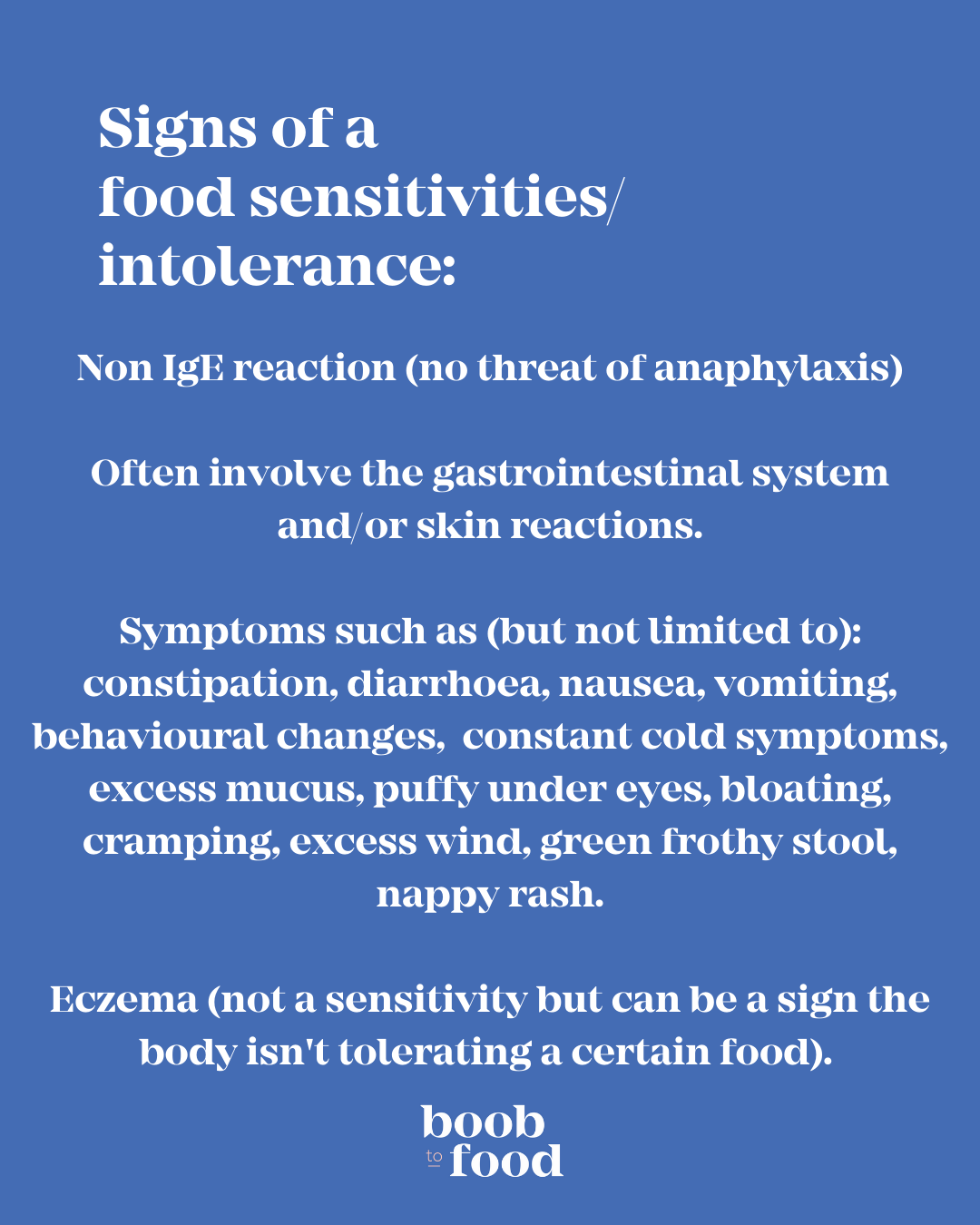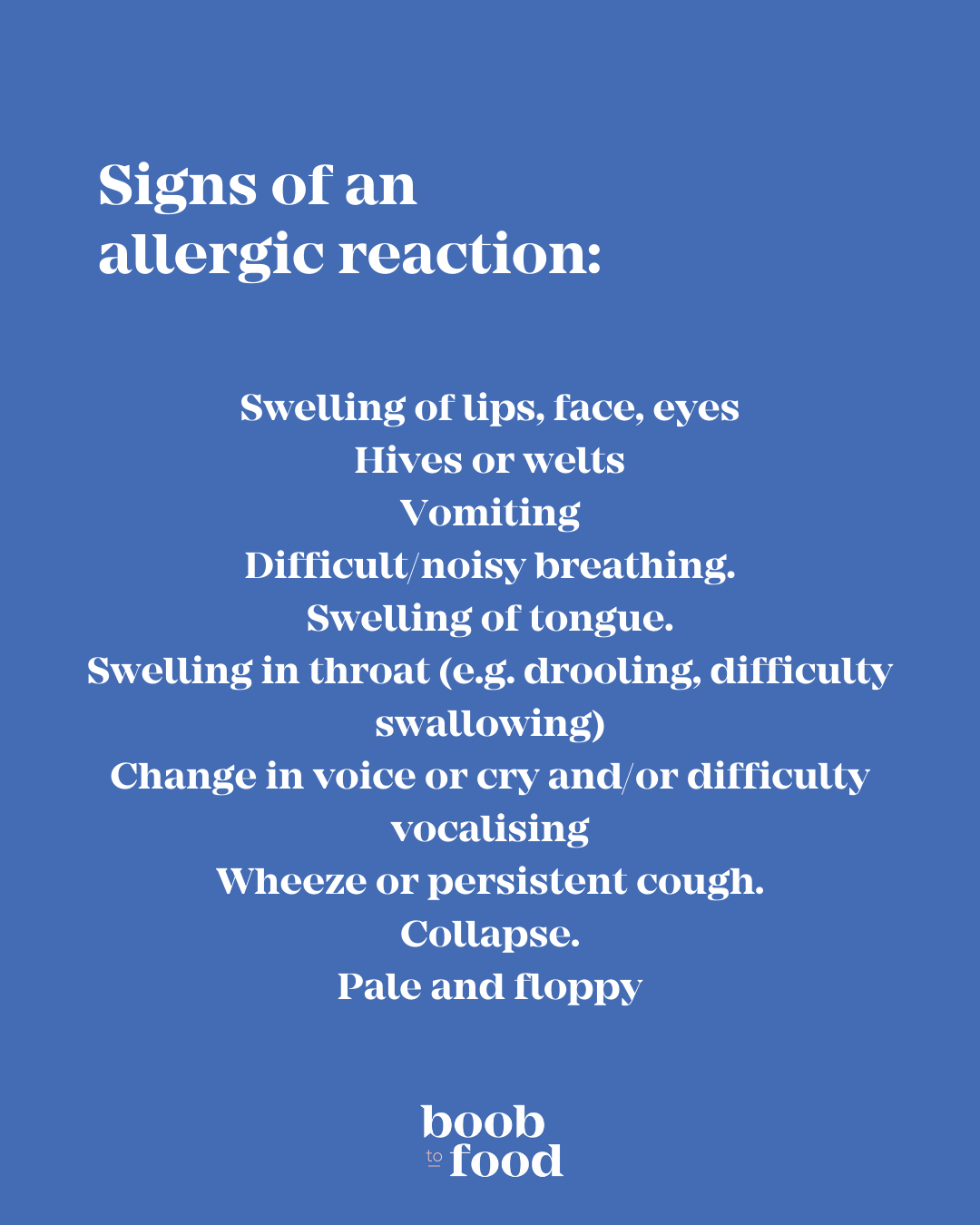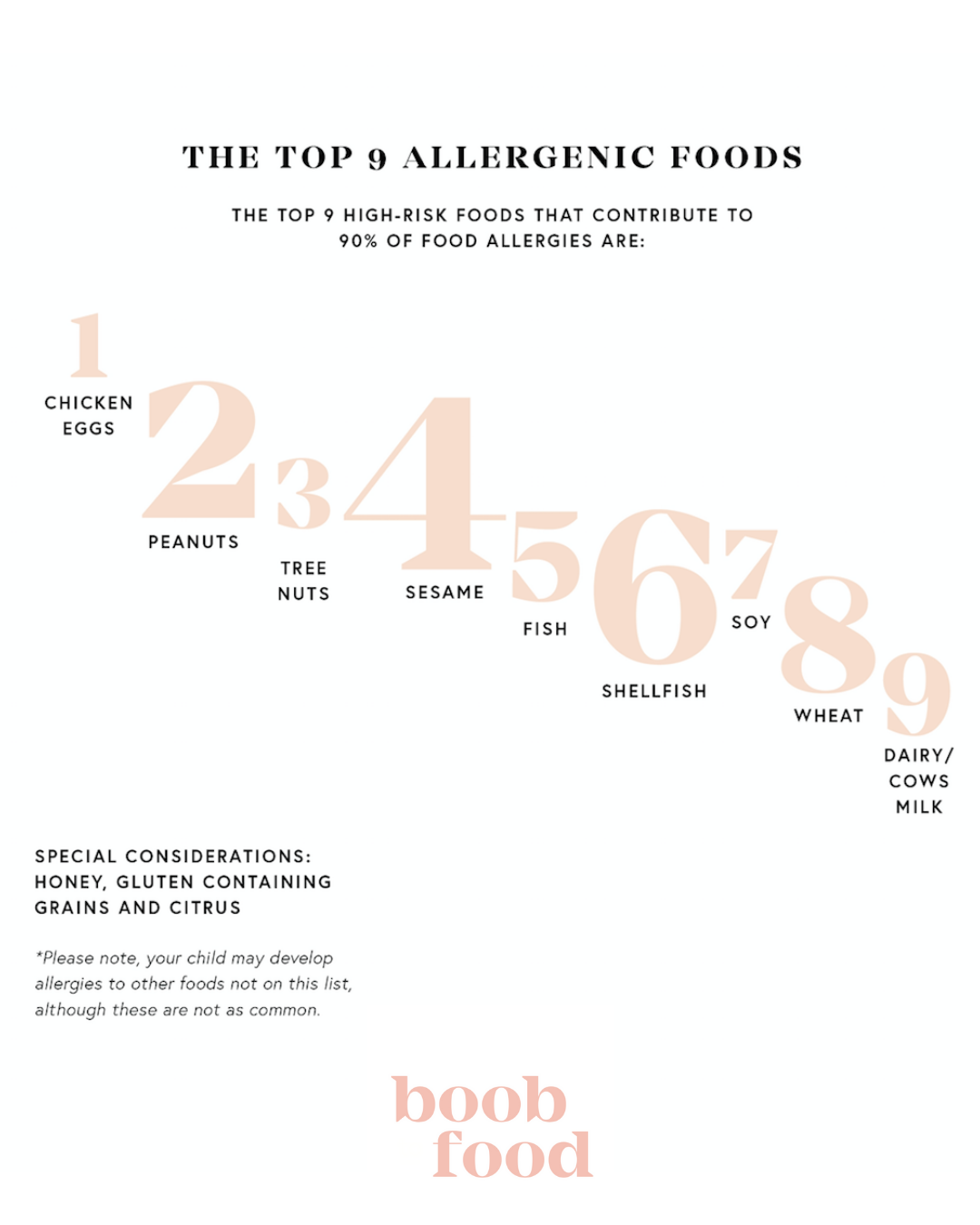WHEN TO INTRODUCE
These foods are not responsible for every allergy, however they are responsible for 90% of food allergies in children.
The current allergy guidelines recommend that these foods be introduced between 6 months and 12 months (but not before 4 months). For the purpose of this blog, I will be listing the allergens from 6 months of age, as that is approximately when I recommend to start your baby on solids – read more about that here. Many expansive studies have now been done that show that the early and frequent exposure (before 12 months) of the top allergens will decrease your babies risk of allergies – so once you do introduce that allergenic food, if your baby tolerates it, try and be mindful to keep that food in rotation in their diet!
It is important to note that some babies may still develop a food allergy despite following this advice. If you suspect your baby has an allergic reaction, stop giving that food and seek medical advice.
When it comes to introducing the top allergen foods, repeat exposure is key.
This is because, your baby may not react to that allergen food from the first exposure, but after that first exposure, can build antibodies to that food protein which can present themselves with the second or third exposure through a histamine release, and an allergic reaction.
I do not say this to scare you, but rather, to educate you that baby is not ‘in the safe zone’ until a few successful exposures to that allergen. The current research recommends repeat exposure of the top allergens to build tolerance and has shown to reduce the prevalence of food allergies. This means, that once your baby has been shown to have no issues with that allergen, try and keep that food in rotation in your babies diet – there is no hard and fast rule with how often you should keep giving that particular food, but just as a part of a varied diet.
HOW OFTEN SHOULD YOU EXPOSE UNTIL ‘SAFE’?
I would recommend introducing the top allergenic foods one at a time, and offer every 3-4 days for 3-4 exposures before introducing any new allergens. You can offer these allergen foods with a food that baby has been tolerating well.
So, why the slow exposure? Can’t you just give them 3 days in a row?
You absolutely can and you will still identify allergic reactions that way, but I do prefer to encourage a slower introduction if possible.
While allergic reactions will generally appear within 2 hours of consuming the trigger food, a food SENSITIVITY or INTOLERANCE generally has a delayed reaction – after 2 hours and within 3 days of consuming the trigger food.
Identifying the potential sensitivity early is going to be a lot easier in the long run than trying to work backwards if your little one does develop any of the sensitivity symptoms 🙂
Many food sensitivities will resolve with time and gut support, and this is definitely something we can help guide you through in a consultation – as the approach is individualised!
We have created a FREE Allergen Tracker Download to support you through your allergen introduction journey. You can download your free tracker HERE
BEFORE YOU INTRODUCE THAT ALLERGEN:
-
Never introduce an allergen for the FIRST time if your baby is unwell. It will be harder to assess if your baby has an intolerance or sensitivity or if that’s part of the illness. They are also more likely to experience a reaction when their immune system is compromised.
-
Don’t introduce an allergen as babies VERY FIRST FOOD. For example, egg yolk can be introduced from 6 months BUT after a few successful introductions to non allergenic food Eg avocado (and yes, some people will be allergic to other foods like avocados, but remember that these are much rarer and the top 9 allergens make up 90% of food allergies in babies).
-
Don’t introduce an allergen food straight before a nap or bedtime. It can take up to 2 hours for an allergy to present itself. I would recommend at the beginning of your babies longest awake time such as mid-morning.
-
Don’t introduce an allergen for the first time somewhere like a cafe or restaurant or at daycare. They should be introduced in the comfort of your home where your full attention is on your baby.
SIGNS OF AN ALLERGIC REACTION:
An allergic reaction will generally appear immediately to 2 hours post consumption/touching of the food.
A sensitivity will generally appear after 2 hours and within 3 days of consuming the food.
WHAT SHOULD I DO IF I SUSPECT MY BABY HAS HAD AN ALLERGIC REACTION?
Immediately stop feeding your baby that food.
Remove them from the food, wipe their face/hands clean.
If required, call an ambulance immediately for signs of a severe allergic reaction such as any difficulty in breathing or if your baby becomes pale and floppy, has tongue swelling or if you’re concerned about their wellbeing.
If it was a mild reaction, DO NOT reintroduce that food again, and seek advice with your general practitioner for the next steps to follow – where they will generally refer your baby for some allergy testing.
WHAT SHOULD I DO IF I SUSPECT MY BABY HAS A FOOD SENSITIVITY?
If your baby develops symptoms of a food sensitivity, please know these can be worked through with a slow and mindful approach. Each circumstance will be individual, so we recommend an individual consultation where we focus on gut-support for your baby and a gentle reintroduction schedule. You can book a consult with one of our skilled nutritionists and naturopaths here.
WHAT TIMEFRAME SHOULD I INTRODUCE THE ALLERGENS?
You may be wondering what order and timeframe you should introduce the top 9 allergenic foods.
There is no specific timeline you need to follow when introducing the top allergenic foods. However, the order they are presented here and on my first food guides (which you can download for free here) are listed in a way that we (@ohbabynutrition and I – this timeline is from our book Milk to Meals) have found to be the most mindful and appropriate approach for a baby’s developing digestive capabilities whilst still meeting the current guidelines of introducing the top allergenic foods between 6 and 12 months of age.
For example, introducing egg yolk as the first top allergenic food, then peanuts, then the different tree nuts, then sesame, then fish, then shellfish, then soy, then egg white, then wheat and finally cows milk.
EGG
I prefer to offer young babies the egg yolk only to begin with for a couple of reasons.
1. They don’t eat a lot, and the yolk is much more nutrient dense than the whites! The whites are a good protein source, but the yolks contain the healthy fats, choline, iron, b vitamins and vitamins a and d!
2. Allergic reactions to the proteins in egg whites are much more common to those an egg yolk allergy. This is a great way to build tolerance to eggs through repeated exposure before you introduce the whites!
3. There’s no right or wrong time to introduce the whites – generally yolks from 6-8 months is great as one of babies first foods (not the very first food, so we can test babies reactions to food in general before introducing allergens), and the whole egg from 8-10 months when baby is eating more quantities and meals!
So, how do you introduce egg?
The more cooked the egg the less chance of reaction. So if you’re concerned about reaction, cook the egg thoroughly!
However there’s nothing wrong with good quality pasture-raised organic egg yolks that are soft boiled – easier to mix into purées and spoon feed to baby! Such as boiling for 5 minutes then cracking open the egg, scoop the yolk out into a purée baby has had numerous times with no issues, or just straight onto a spoon!
For BLW an egg yolk omelette cut into finger shapes is great! Try grating in some liver before cooking for some extra nutrients
PEANUTS
Technically not a nut (they are a legume) peanuts are very different to your tree nuts (cashews/almonds etc).
Peanuts can be introduced from 6 months + (just not as the very first food you try!). Like all allergens, trial at least 1/4 tsp and for At least 3 exposures trying to increase the amount each time if no signs of reaction.
How to introduce:
1. Smooth, unsalted peanut butter. This is too claggy on a spoon by itself which can be a choking risk, however you can mix it with some coconut oil so it is a smooth and runny consistency, or mix into a purée or top finger foods with the peanut butter (just make sure it’s paired with a good that they’ve had numerous times before! E.g. don’t give peanut butter on toast if they’ve only had toast once or twice!)
2. You can also just buy some peanuts, grind them into a very fine powder with a mortar and pestle or blender and dust finger foods or add this powder into purée!
If your baby tolerates peanuts after the 3 exposures, try and keep them in regular rotation in their diet to maintain exposure!
TREE NUTS
Tree nuts get confusing – because they are all individual species! Which means they need to be tested INDIVIDUALLY! This includes (but not limited to) almonds, cashews, macadamia nuts, Brazil nuts, pecans, pine nuts, pistachios, walnuts, chestnuts.
For example, you can have a cashew allergy, but be fine with almonds etc.
Tree nuts can be introduced from 6 months + (just not as the very first food you try!). Like all allergens, trial at least 1/4 tsp and for At least 3 exposures trying to increase the amount each time if no signs of reaction.
How to introduce:
1. Smooth, unsalted nut butter E.g. almond nut butter. This is too claggy on a spoon by itself which can be a choking risk, however you can mix it with some coconut oil so it is a smooth and runny consistency, or mix into a purée or top finger foods with the nut butter (just make sure it’s paired with a food that they’ve had numerous times before! Eg don’t give almond butter on toast if they’ve only had toast once or twice!)
Just be mindful with many nut butters they are often mixed with other nuts and it can be hard to find a pure nut butter so always check the ingredients!
2. Or the easier and cheaper way, You can just buy a handful of the nuts you want to test (ie almonds), grind them into a very fine powder with a mortar and pestle or blender and dust finger foods or add this powder into purée!
If your baby tolerates that nut after the 3 exposures, try and keep them in regular rotation in their diet to maintain exposure!
It’s going to take a while to get through all these nuts (and this list isn’t exhaustive of all nuts either!) so start with the nuts that are most prevalent in your own diet so that you can relax when your baby grabs a handful of your food unexpectantly!!
SESAME
In Australia sesame is listed as one of the top 9 allergenic foods but not in many other countries
Sesame can be introduced from 6 months + (just not as the very first food you try!). Like all allergens, trial at least 1/4 tsp and for At least 3 exposures trying to increase the amount each time if no signs of reaction.
How to introduce:
1. Hulled tahini. This is too claggy on a spoon by itself which can be a choking risk, however you can mix it with some coconut oil so it is a smooth and runny consistency, or mix into a purée or top finger foods with the tahini (just make sure it’s paired with a food that they’ve had numerous times before! Eg don’t give tahini on toast if they’ve only had toast once or twice!)
2. Or you can coat some finger foods/top purée with some sesame seeds! Sesame seeds coating finger foods also works really well as a coating so little fingers can pick up the food easier!
If your baby tolerates tahini after the 3 exposures, try and keep them in regular rotation in their diet to maintain exposure!
FISH
Generally this is around 8-9 months if you’re following this introduction timeline, after the egg/peanuts/sesame.
Many fish allergies actually develop in adulthood, however there is still research to say the earlier introduction is shown to reduce the risk of developing a fish allergy.
Fish species are different, however, if your baby is allergic to one species of fish, the recommendation is to avoid all fish.
What to look for:
Most fish allergies are to salmon, tuna and halibut, so it is recommended to start your baby on a different species of fish. I love for babies sardines or mackerel, as they are incredibly nutrient dense specifically in DHA which is crucial for brain development, they are also low in mercury. Most white fish are also great and low in mercury such as whiting or hake.
I would also recommend WILD caught if possible. This means the fish hasn’t been farmed (generally fed pellets/soy/grain/antibiotics etc as opposed to their natural diet), so they will be much more nutritious.
If choosing canned fish, opt for no flavours added, fish in water or olive oil only and preferably BPA-free can.
How to offer:
PUREE: You can mix fish of choice into a puree baby has had numerous times with no reactions. I.e. canned/drained sardines and avocado.
FINGER FOODS: Fish makes the PERFECT finger food! Ensure no bones are in the fish (except canned sardines/mackerel those bones are great and so high in calcium!)
Cook fish as you wish I.e oven baked, parcel baked, pan fried. Then offer baby ‘flakes’ of fish in large finger shape pieces. Or if baby has developed a pincer grasp by then, you can offer small pieces.
Remember to offer at least 3 exposures trying to increase the amount each time if no signs of reaction. If your baby tolerates fish after the 3 exposures, try and keep fish in regular rotation in their diet to maintain exposure!
SHELLFISH
Shellfish come in two species – crustaceans and molluscs, and they need to be tested separately.
Crustaceans are your foods like prawns, shrimps, crabs and lobsters.
Molluscs are your foods like oysters and mussels.
Whilst these foods can be SO beneficial and nutritious (especially oysters – so high in iron and zinc) there are a few things you need to be wary of:
1. Biggest issue as these foods pose a textural issue and choking risk.
2. These foods need to be well cooked due to food poisoning risks.
So, what is the safest way to prepare these foods?
Prawns: pan fry and offer thin slices, or mince and offer on its own or puréed into a meal they have had numerous times with no issues.
Oysters: smoked, canned oysters are great as they are already cooked! You can mince and offer on their own or puréed into a meal they have had numerous times with no issues. You can also offer very thin strips.
You can offer fresh oysters but I would advise cooking due to the food poisoning risks!
Remember to offer at least 3 exposures trying to increase the amount each time if no signs of reaction (see previous posts for details on this). If your baby tolerates shellfish after the 3 exposures, try and keep shellfish in regular rotation in their diet to maintain exposure!
SOY
If you follow my first food guides you’ll see that I recommend introducing soy after 8 months, in the form of organic tempeh or squashed/puréed shelled edamame beans.
I choose to use tempeh to introduce soy to babies, as it is fermented and easier to digest. This is because the fermentation breaks down the phytates and some of the enzyme disruptors that soy can contain.
When choosing your tempeh, always choose organic, to endure it’s not GMO and soy tends to otherwise be very pesticide heavy.
Tempeh makes a great finger food option, or you can pan fry and then blend with a vegetable of your choice for a purée!
Shelled edamame is also a great choice if you can find it organic (often found in the freezer section!)
Remember, like all of the top allergens, the recommendation is for atleast 3 exposures to that food. Soy and dairy sensitivities often go hand in hand, so if you suspect your little one is sensitive to dairy be very mindful of similar reactions when introducing soy!
DAIRY
Dairy is a bit of a tricky one, as there are different forms of dairy and some are better tolerated than others. CMPA is a cows milk protein allergy, most often diagnosed way before solids have been introduced through a reaction to the cows milk protein passing through breastmilk if the mother consumes dairy, or through dairy based formulas. It is most often outgrown and usually dairy is eliminated for 6 months then retested under the guidance of an allergist.
What I hear of more commonly, is lactose sensitivity/intolerance – and something both my children have had and worked through!
This is how the concept of the ‘dairy ladder’ was created (and reaffirmed in my studies with Oh Baby Academy). Carley and I created this ladder for ‘Milk to Meals’ to help guide you through mindfully introducing dairy to your little ones, to hopefully identify early any potential sensitivities and build tolerance to lactose in a gentle way for your babies developing digestive system – because not all forms of dairy are equally tolerated by their delicate digestive systems!
The dairy ladder is all about starting with the easiest to digest forms of dairy; those lower in lactose and higher in fat and/or probiotics, and working your way up the ‘ladder’.
Please note, this is not the only way and timeframe to introduce dairy – the main factor is that you introduce each form of dairy a quite a few times to watch for any possible reactions before moving up the ladder. Test each food Atleast 3 times, 3 days apart to test for any potential sensitivities.
WHEAT
Wheat is a bit tricky, as it contains gluten but not all gluten-containing grains contain wheat!
Because gluten is a common intolerance or sensitivity, it’s great to start with a non-wheat, gluten containing grain first and check that there are no signs of a gluten issue. This includes spelt, barley and rye.
Once you have ruled out any issues with gluten (3 exposures atleast 3-4 days apart), then you can move onto a wheat-containing grain – such as einkorn flour, emmer wheat, sourdough, 100% whole wheat bread, 100% whole wheat pasta.
Wheat IS an allergen so be mindful of the signs of an allergy when introducing.
I know a lot of people are really keen to get their babies having bread from an early age – and I get it; breads easy and not too messy however, remember that so many adults digestive systems cannot handle bread, it can be hard to expect all babies with their immature digestive systems to handle it too!
Normally I say wait until 10-12 months to introduce this allergen – so that baby has had a good few months to learn to digest food and strengthen their gut microbiome! When you do choose bread – a really good quality sourdough is a great option!
Before this age, try making a paleo bread! (Such as our recipe in milk to meals) or bread like a zucchini bread! Way more nutritious and much easier digested!
A great pasta option before you’ve introduced wheat can be a pulse pasta such as red lentil pasta or a pea pasta! Again, more nutritious, high in protein and better tolerated!
We have created a FREE Allergen Tracker Download to support you through your allergen introduction journey. You can download your free tracker HERE
REFERENCES:
https://www.allergy.org.au/images/pcc/ASCIA_PCC_How_to_introduce_solid_foods_FAQ_2019.pdf
https://www.allergy.org.au/patients/allergy-prevention
https://www.allergy.org.au/hp/papers/infant-feeding-allergy-prevention
https://www.allergy.org.au/images/stories/pospapers/ASCIA_HP_Clinical_Update_Infant_Feeding_and_Allergy_Prevention_July2018.pdf
https://preventallergies.org.au/helpful-tools/the-learning-early-about-peanut-allergy-leap-study/








+ show comments
- Hide Comments
add a comment